THE $100 REWARD IS REAL! Scroll down for info.
Raise your fist with Myra Dietz, perhaps Wisconsin’s bravest heroine of all time. But watch out—the Winchesters are loaded and bullets will fly!
Thornapple Girl (Ships Free) |
|

$ 17.99 USD |
|
|
A 1910 NW WI TRUE-CRIME NOVEL
Step into the life of Myra Dietz, a girl whose voice is as sweet as her determination is strong. Meet Myra’s father, John, a steadfast Winter, Wisconsin, woodsman who confronts the world’s largest lumber syndicate. But rather than pay John his back pay, they respond with government graft and corruption. Warrants are issued for John’s arrest. Shots are fired. Headlines explode coast-to-coast! Get to know this struggling but loving family, regarded nationwide as champions of the working class. Raise your fist with Myra Dietz, perhaps Wisconsin’s bravest heroine of all time. But watch out—the Winchesters are loaded and bullets soon fly! • Based on news accounts, court records, and Myra’s own personal recollections. 107 images and excerpts from Myra’s 1929 memoir. 228 pages. Written for adults, yet suitable for young readers. • (SHIPS FREE, WI Sales Tax Paid!) |
|
Mix-OR-Match! Purchase ANY 3 BOOKS for only $49.99, shipped free with your Wisconsin Sales Tax paid by the publisher!
(See the HOME page for our 3-book ordering information.)

Like most of the author's other books, this is a softcover, b&W interior, illustrated. It has over 250 pages filled with our exciting Northern Wisconsin history. Thornapple Girl takes place in the early 1900s near Winter, Wisconsin and is filled with scenes from the greater Sawyer County region. Join the Dietz family as they struggle to overcome the odds and America's 8th-ever wealthiest man, Frederick Weyer-haeuser.
Order now and receive a signed copy, fresh off the press. It's based on press accounts, court records, and Myra's own memoir, lost in 1929 but now in the hands of the author. CLICK HERE to see this rare manuscript!
Excerpts of Thornapple Girl are below!
Step into the life of Myra Dietz, a girl whose voice is as sweet as her determination is strong. Meet Myra’s father, John, a steadfast Northwest Wisconsin woodsman who confronts the world’s largest lumber syndicate.
When John asks for his back wages, the lumber company refuses. He then learns that the dam they’ve been using for log drives is on HIS land! The syndicate could lose millions. But rather than settle, they respond with government corruption. Warrants are issued for John’s arrest. Shots are fired. Newspapermen flock to Sawyer County. Headlines explode coast-to-coast!
Get to know this struggling but loving family, once regarded nationwide as champions of the working class. Stand with them against the eighth-wealthiest American ever, timber tycoon, Frederick Weyerhaeuser.
Raise your fist with Myra Dietz, perhaps Wisconsin’s bravest heroine of all time. But watch out—the Winchesters are loaded and bullets will soon fly!
Thornapple Girl is …
... Based on news accounts, court records, and Myra’s personal recollections.
... Complete with many illustrations, press clippings, and excerpts from Myra’s 1929 memoir.
... Created by James Brakken, Bayfield County’s award-winning author of historical fiction.
... Written for adults, yet suitable for younger readers. Available from com along with the complete 1929 Myra Dietz memoir, The Heroine of Cameron Dam, edited by Sybil L. Brakken in 2020 for its first public debut.
THE $100 REWARD IS REAL! Keep scrolling down for info.

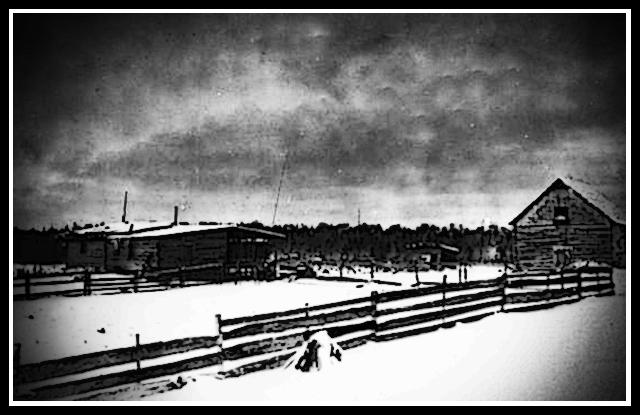
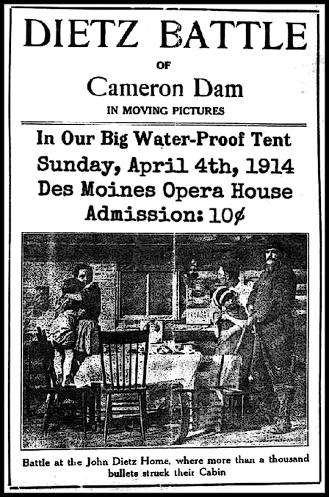
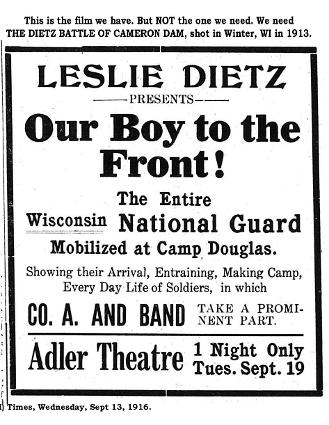
$100 REWARD!
I’m looking for “Internet detectives” to help recover a piece of Wisconsin’s rich history. And I’m offering a $100 reward!
I am James Brakken from Bayfield County, author of 12 WI books set in days long passed. They include my latest book, THORNAPPLE GIRL, the story of Myra Dietz, caught up in the outrageous 1910 struggle between her father and America's wealthiest timber tycoon. Research for THORNAPPLE GIRL, caused me to stumble across an important Wisconsin silent film from 1916, but NOT the one I was looking for.
I need your help finding the “lost” film from 1913. Below you'll see that I'm offering a $100 reward for its recovery. You might be the person who discovers the lost Myra Dietz film. Or perhaps one of your friends? Here’s the background:
I recently finished a novel about Myra Dietz and the 1910 Battle of Cameron Dam. Working with the WI Hist Society, (WHS) I discovered a film, OUR BOY TO THE FRONT. It’s an early documentary that helped the John Dietz children raise $ to get their father released from prison after being sentenced to life for a murder he did not commit. My book, THORNAPPLE GIRL is based on the lives of this family. The film that I found was directed by Leslie Dietz and features Myra, but OUR BOY TO THE FRONT is NOT the film WHS and I hoped to find.
ABOUT THE MISSING FILM: Myra Dietz nearly died from gunshot wounds fired by "on the take" lawmen in 1910. A week later, 100 armed, deputized thugs fired 1,000 bullets into the family farmhouse, hoping to kill Dietz & his wife & children. John surrendered and was thrown in prison. Later, Myra and her brothers began a speaking tour to raise $ and get signatures in order to get dad out of prison. At first it was just them speaking, earning a 10 cent/ person admission fee. Next, Myra hired a photographer who made glass slides that were shown during the talks. More dollars came in. Then, in 1913, Myra hired a NY movie maker to shoot a 3-reel, 35 mm documentary of the ordeal. Filmed in Winter, WI, most of the characters played themselves. Three copies were made of THE DIETZ BATTLE OF CAMERON DAM.
In cooperation with the film archives at the WI Hist Society, I am searching for any one of the 3 copies of the 35 mm film titled THE DIETZ BATTLE OF CAMERON DAM. When I find it, the WHS will restore it and make a digital master, allowing all WI libraries and historical museums to show it.
And someone will receive a hundred bucks directly from me for helping us to rescue the film and our history. If you or someone you know would like to go Sherlock Holmes on this project, I've got $100 set aside for the person who solves the case. In turn, I'll get it to the film archivist at the WI Hist Soc. We can get the film restored and digitized so every WI library and hist soc. can download and share it -- and you'll get credit as the detective who saved this important piece of WI history. That C-note will be yours, too, if you're the one who cracks the case and finds the lost film.
I urge you to use your social networking and other Internet skills to seek out this 3-reel, 35 mm film. When you find it, keep it cool and avoid exposing it to air by keeping the film canisters closed. Both heat and oxygen tend to degrade these old nitrate films. Message me for details regarding the missing film if you wish. Thanks and good luck with your detective work. And PLEASE feel free to share this message with others. Good luck and stay well. James Brakken
More about the missing film at bottom of page.
EXCERPT FROM THORNAPPLE GIRL
Prologue
Thornapple Farm
October 1, 1910
A young newspaperman for the Minneapolis Tribune stood on a footbridge stretching across Northwest Wisconsin’s narrow Thornapple River. He wore a high button, single-breasted jacket with narrow lapels paired with blue, pinstripe trousers. In his left hand, he carried a leather satchel. In his right, he held a straw skimmer that he waved overhead, hoping to get the attention of those on the farmstead across the river. Behind stretched a ten-mile walk to the small lumber town of Winter, now crowded with other reporters. Like him, each one hoped to get a new angle on a story six years in the making—the story of a farmer standing in defiance of America’s most powerful lumber syndicate and its creator, Frederick Weyerhaeuser.
“Hello?” the reporter shouted. “Mr. Dietz? Are you there?” He listened for a reply. Instead, he heard a young woman singing. “East Side, West Side, all around the town. The tots sang, ‘ring-around-rosie, London Bridge is falling down.’”
Her clear, angelic voice carried across the meadow. “Boys and girls together, me and Jimmy O'Rourke.” The reporter leaned forward. “Tripped the light fantastic on the sidewalks of New York.” There, ahead, he saw the dark-haired young woman with the sweet voice. She carried two pails of water toward the cabin.
“Can I help you with those?” he asked. She turned with a jerk, splashing water onto her white apron and button shoes.
“Father!” she shrieked. “Father, someone’s here! Father!” She turned back to the young man. “Who the blazes are you?”
“Floyd Gibbons,” he replied. “From the Minneapolis Trib. You must be Miss Dietz. I’ve read your columns.”
“Yes. I am.” She nodded toward the cabin. “And he is my father!”
The screen door sprang open. In two bounds, a lean, mustached man carrying a rifle jumped off the porch. As he rushed toward them, a second man, younger and also armed, stepped out. Then a third, scanning the river bottom with binoculars.
“And those must be your brothers, Clarence and Leslie,” said Gibbons.
John raised his rifle. “Myra! Get away from him! Get back!”
“I mean no harm, Mr. Dietz,” said Gibbons, raising his hands. “I’m Floyd Gibbons. From the Trib. I’m here to get your side of the story.”
“How do I know you’re not some spy sent here by the lumber syndicate?”
Myra set her pails on the ground. “He is who he says, Father. I recognize him from his photo in the newspaper. Mr. Gibbons’s articles have been quite sympathetic all along.”
John stared at Gibbons and then lowered the rifle. “What’s in that grip you’re holding?”
“Only pencils and paper, sir. And an apple for my dinner.”
“Save your apple for another day,” said John.
“Sir?”
“Our guests sit at the same dinner table as we do. If my daughter says you’re on the level, that’s good enough for me. Now come meet the rest of the family.”
Gibbons handed his satchel to Myra and picked up the water pails. “I’m terribly sorry I startled you.”
Myra looked down at her water-soaked shoes. “Oh, no real harm done, Mr. Gibbons.”
“Please,” he said with a smile, “call me Floyd. All my friends do.”
Below: The Dietz family's defense of their home and their rights inspired millions of Americans across the nation. Note that the Portland, Oregon illustration shows Myra with a rifle. Rumors of her being a crack shot, ready to take down any intruder with a bullet were false & fostered by the Sawyer County authorities. In truth, Myra was deathly afraid of guns and, by her own testimony, never once fired a rifle.
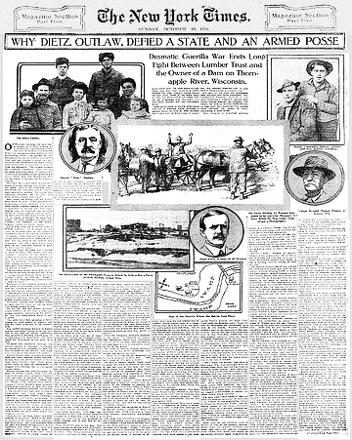


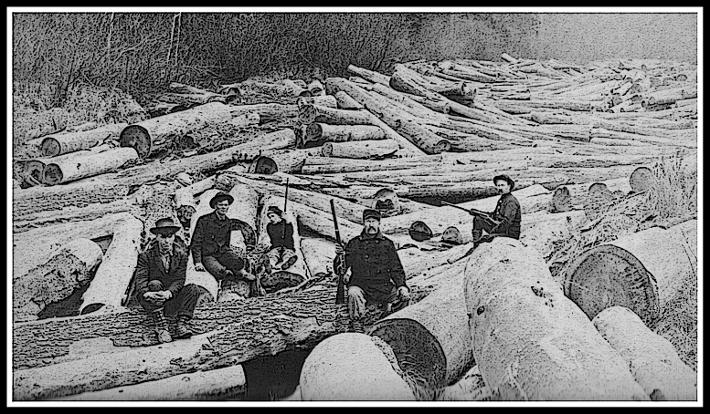
The words Myra reads in this chapter are direct quotes from the Chippewa Herald.
13
All Lies!
The next morning, when the boys came in from chores, they found Myra at the table reading a copy of the Chippewa Weekly Herald.
“Where the heck did you get that?” asked Clarence.
“Clarence Dietz!” shouted Hattie. “You want your mouth washed out with soap again?”
“I’m sorry, Ma. Wasn’t my fault. It sort of slipped out.”
Myra shook her head. “Helen and Stanley were playing outside after breakfast. They found the paper stuck in the woodpile.”
“You mean someone came into our yard last night?” asked Leslie. “Who in the world …?”
“Stanley,” said Hattie. “Fetch Father from the barn. He needs to know about this.”
Minutes later, Stanley followed his father into the kitchen.
“What’s so dag-blasted important that I can’t tend to my work?” asked John.
“Pa,” Leslie said, “somebody hid a newspaper in the woodpile last night.”
“I heard no shepherd’s bark,” he replied.
“It must have come from a friend,” said Myra. “A person the dogs trust.”
“Brought by the light of the moon?” said Clarence.
“More likely brought while we were at chores,” said Leslie.
“Father,” said Myra, focused on the paper, “I think I know why someone brought us this newspaper.”
The others turned to her as she began reading.
“Deputy sheriff is murdered!” she exclaimed.
“Murdered?” shouted John. “A lawman? Where ’bouts?”
“Not far from here. Listen, Father.” Myra read from the newspaper. “Desperado slays deputy. Escapes to the woods on Winter Road. Posse in pursuit. Desperate fight is looked for.”
“My heavens,” said Hattie. “How could such a thing happen?”
Myra continued. “Sheriff’s Deputy, William Elliott, fatally shot along the Winter Road by John Dietz, who …”
“Me?” asked John. “They accuse me?”
“… Who, with his family, has been holding up the Chippewa Lumber and Boom Company's drive at the Cameron Dam”
Her father interrupted again. “Hogwash! It’s all nonsense. What other lies did they print?”
Myra continued. “Dietz has been holed up on the Thornapple River with rifles for the past two weeks. An injunction was issued, but he paid it no attention.”
“The company is trying to turn the public against me,” he said. “Making me look like some animal. Go on, Princess. Read on.”
“Dietz told the sheriff he did not care if President Roosevelt himself issued the injunction.”
“There’s the first thing said that’s right,” he said. “Go on.”
“Sawyer County Judge John K. Parrish ordered Dietz arrested Wednesday. The sheriff was driven away by Dietz. The Judge then ordered the sheriff to capture the desperado with a posse. Deputies Giblin, Mulligan, and Elliott left for Dietz’s home, believing they could affect the arrest without a posse. When the dam was reached, Dietz rushed from ambush, ordered them to hold up their hands, and fired, fatally wounding Elliott. Dietz then hurried into the woods and has not been located. The posse is now scouring the woods. It is believed that Dietz will not be taken alive.”
“Will not be taken alive?” Hattie shouted.
“The sheriff ordered his deputies to get the drop on Dietz and kill him if necessary. Dietz is a desperate character. For ten years he has lived in abandoned lumber camps, hunting, fishing and trapping.”
“All lies!” shouted John. “Ten years, indeed! They make us sound like squatters. And for them to announce to the world that I murdered some deputy? What nonsense!”
“We know better, Pa,” said Leslie. “It’s all claptrap to make you look like an desperado.”
“Go on, Myra,” said Hattie.
“Dietz was sheriff of Barron County at one time,” read Myra.
“Another lie,” said Clarence. “That’s Uncle William who was sheriff there. Who writes such gobbledygook?”
Myra continued. “The dam in dispute was built in 1877. The Chippewa Lumber and Boom Company owns land on the north side and claims that it has owned it for four years. Two weeks ago the company sent their surveyor Thomas Sargent to interview Dietz. Sargent found him desperate. Deitz demanded ten cents per thousand board feet for logs that had passed through the dam in the past four years. He wanted from $15,000 to $20,000. He refuses less and continues guarding the dam with Winchesters.”
John huffed. “Well now. Sounds to me like they’ve raised the stakes. I asked only for nine thousand. They say fifteen? Twenty? Perhaps it is time I raised my demand. What else does it say, Myra?”
She read on. “The logs are held at another dam above the Cameron Dam and cannot be brought to this city. Dietz frequently fired at men who attempted to get logs over the disputed dam.”
“More lies,” he said. “I fired only three times and not once near enough to any company man to do harm. And I sure as heck didn’t murder any sheriff’s deputy.”

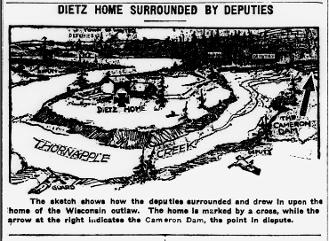
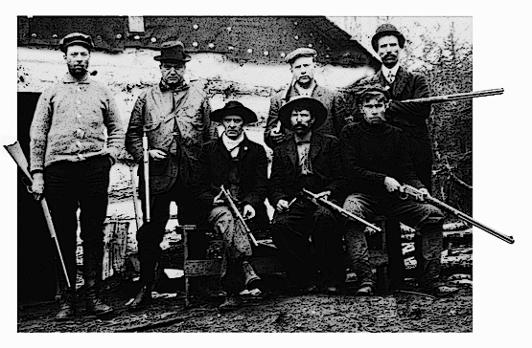
From Chapter 32: Old Paul
Within weeks, sunshine and warm weather transformed the Thornapple River bottomland to the rich greens of spring. The Dietz farm sparkled in the sunshine. In the south pasture, the cows devoured the grasses now shooting skyward. In the barnyard, hens and chicks pecked at bugs, grasses, and seeds, and old Paul grazed out in the pasture with Suzybell, the replacement workhorse for their dear Meggie. Long after her passing, songs of joy sung by Myra and the children flowed across the farm fields. Livestock confined to the barn over the winter, now meandered around the pasture like tourists on holiday. Then, one morning, as Leslie headed to the barn to begin chores, he saw Paul asleep near the barn. Leslie whistled. Paul raised his head and lowered it to the ground again. Leslie came closer. Something seemed wrong.
“Paul? Paul!”
The huge, black draft horse didn’t move. Leslie quickened his pace, whistling again.
“Paul!” he shouted. The horse lifted his head again. Closer, now, Leslie saw it. Blood. Blood on Paul’s neck. Blood on the grass underneath. He rushed over and knelt, seeing a wound. He stroked Paul’s forehead. “What happened, fella? Did you run into the fence?” Leslie placed his hand on the puncture wound on Paul’s neck. Wet with blood, his fingers probed the wound. Leslie jumped to his feet and raced to the cabin.
Inside, the family heard Leslie’s shouts.
“Pa! Come quick! Paul’s been stabbed!”
John knelt next to Paul, stroking his forehead as Leslie had done earlier. The entire family stood there, silently waiting for the head of the family to speak. Holding back tears, Clarence asked, “Must we put him down, Pa?”
“I don’t know, Clare. Depends on how he does through the morning.” John stood. “Leslie, go fetch the kit. We need to clean the wound, apply liniment, and bandage it if we hope to stop the bleeding. Run, now. Hear?”
“Right, Pa,” shouted Leslie, already on his way to the cabin.
“Father, who could have done such a thing?” sobbed Myra.
“Someone who doesn’t know a fiddly fig about horses.”
“What makes you say that?” asked Clarence.
“If he knew what he was doing, he’d have sliced through the jugular. Or stabbed into the lungs. If so, old Paul would be gone by now. No, this villain didn’t know a fig about horses.”
“John,” said Hattie, “you know very well who did this.”
Myra turned. “Who, Mother?”
“Those so-called lawmen across the river. Sworn to keep the peace. Instead, they prey upon defenseless animals. Keep the peace, indeed!”
“Sent by Red Mulligan, I’d wager,” added Clarence.
“I can’t watch this anymore,” said Hattie. Taking Johnny by the hand, she hurried back toward the house.
“Father,” said Myra, stroking Paul’s forehead, “how could a human being do such a thing to a kind, gentle animal like our Paul?”
“There are cruel men in this world, Princess. Men who will stoop low. They’ll do anything to damage a foe, even strike down a dear sweet horse like old Paul.”
“But think of it,” she said. “Paul probably just stood there while this villain strolled up, stroked Paul’s forehead like I’m doing now and then heartlessly plunged a dagger into his neck. Knowing Paul, he probably just stood there and let the villain do his evil deed, and then watched him walk away. Old, trusting Paul.”
Leslie rushed up with the family medical kit. “Here, Pa,” he said, out of breath.
“Turpentine, Son.”
“Here you go.”
The others watched John pour it onto the wound. Paul blinked, but didn’t raise his head from the bloodied ground.
“Now your mother’s Carbolic liniment.”
Myra unscrewed the lid from the jar. “Here, Father.”
Using three fingers, John scooped out half-a-handful of ointment. “Clare, I need you to pull a hair from Paul’s tail for the stitches. Myra, find a big needle.”
“Yes, Father.” Myra pulled a curved needle from the kit, wiped it and the horsehair with turpentine, and then threaded the needle. “Here,” she said, handing it to her father.
They watched as John placed five sutures in the gaping knife wound, tying each as he did.
This excerpt comes from Chapter 15, Master J. C. Gates
The next day, as Helen and her mother finished washing the mid-day dishes, they heard a shout from Stanley, playing in the front yard.
“Mama! Come see!”
“What is it?” Hattie yelled through the kitchen window.
“Men, Mama!”
Hattie stepped outside. Stanley pointed beyond the dam. “Over there! See?”
Hattie stretched, staring beyond the pine stumps and summer haze. Two figures stood on the far side of the Cameron Dam’s catwalk. “Stanley, where’s Papa?” she asked.
He pointed in the opposite direction. “That way.”
She turned, peering far across the pasture to see John, Clarence, and Leslie repairing the north fence. Both dogs accompanied them, hundreds of yards away. Hattie turned back to the strangers, and then rushed inside for the field glasses. Helen followed her outside, carrying little Johnny. Myra came next, loading a Winchester.
Hattie fumbled with the binoculars and raised them, turning the focus ring back and forth.
“Who is it, Mama?” asked Helen.
“I can’t tell.” She adjusted the binoculars and then looked through them again. “Oh, these darn spyglasses!”
“Trade!” said Myra, handing her the rifle. Then, “Oh, my stars!” she exclaimed. “Can it be?”
“Who is it?” Helen asked again.
“I think that’s … Uncle William. Yes! What in the dickens?”
Hattie waved her arm vigorously to invite John’s brother across.
Hattie turned north again. “John,” she yelled across the pasture. “John!”
Realizing her call went unheard, Hattie pointed the rifle skyward and pulled the trigger. The crack of the rifle shattered the still afternoon air. Little Johnny bawled. Near the dam, William Dietz and the man behind him dove to the ground. To the north, the men stopped their fence work to look. Both dogs streaked toward the cabin, barking.
“Mother!” cried Myra. “What were you thinking? You scared the wits out of the lot of us!”
“Oh, dear,” Hattie replied. “But, look.” She pointed north. “Here comes your father.”
John and his sons spanned the pasture on the run, reaching the front porch only moments after the dogs. “What is it?” said John. “Why did you shoot?”
Hattie pointed toward the dam. “We think we saw William.”
“Uncle Will?” asked Clarence. “You shot at Uncle Will, Ma?”
“What? Oh, my, no!” replied Hattie. “I shot merely to summon your father.”
“Well, Mother,” said Myra, “I dare say it worked.”
“But … where is Uncle Will?” asked Clarence.
Facing the dam, Hattie bellowed, “William! All is safe, now.”
The family watched as, two hundred yards away, John’s brother slowly emerged from the waist-high marsh grass along the river. He looked side to side and behind as he brushed off his coat and trousers. The second man stood, clutching a carpet bag in each hand.
Clarence waved. “Hello, Uncle Will!”
John cupped his hands around his mouth. “It’s all right, William,” he shouted. “You fellows won’t be ducking any more of Hattie’s bullets.”
The callers crossed the yard and stepped onto the porch. Hattie smiled sheepishly, noticing the stern look on William’s face and grass stuck in his collar. “Oh, dear me,” she sighed.
“John,” he said. “I spent six years as sheriff of Barron County and only once had the bejesus scared outa me by gunfire. Your better half just doubled that score.”
Hattie handed the rifle to Clarence. “Oh, my. I’m so sorry, William.”
“Aw, no harm done, Hattie. But next time ring the gol-dang dinner bell. It’s less likely to give a body the fits.”
More on THE SEARCH FOR THE 1913 CAMERON DAM FILM from James Brakken …
I believe Jack Dietz, AKA John F. Dietz IV and the grandson of the ill-famed John F. Dietz, had one of the 3 copies of the film. I think he lived in Boca Raton, FL but retired to his home in Three Lakes, WI. His sister, Priscilla, told me the film cans were kept there. Jack had a son he named John F. Dietz V who I believe lived in Eagle River, not far from Three Lakes. He might be the one with the films. I've tried several times to locate him, but no luck. At some point in time, Jack dontated some materials either to a local museum or to the WHS in Madison. But the film in the WHS archives is the 1916 OUR BOY AT THE FRONT, not the 3-reel 1913 film. I wonder if the other film was sold to a local collector or antique shop. Or perhaps left at a local historical society. Or it could still be in the back room of some old movie house. Probably in WI or MN or somewhere in the Upper Midwest, but who knows? And there were 3 copies made, so they could be anywhere.
Here's the gist of the story: The 8-year-long ordeal experienced by the Dietz family at the hands of Frederich Weyerhaeuser, the wealthiest of all the timber tycoons, gained nationwide interest when Myra's older brother was shot by crooked deputies while making hay during the summer of 1906. After the family endured many more assaults and infringements, Myra was shot and arrested. Older brother, Clarence, was also shot and jailed. A week later, 100 deputized thugs fired 1,000 rifle bullets into the Dietz home, trying to kill the family. All survived. John surrendered, then was told a deputy had been shot and killed. He would stand trial for murder, even though an actual crime was never established. Some insiders said the body was brought from Chicago and planted to make it look as though Dietz killed him. Others said nobody was shot that day.
Myra nearly died from her gunshot wounds. Well after 66 days in the hospital, she and her brothers began a speaking tour to raise $ and get signatures to help get dad out of prison. At first it was just them speaking, earning a 10 cent admission fee. Then Myra hired a photographer who made glass slides that were shown during the talks. More $ came in. In 1913, Myra hired a NY movie maker to make a 3-reel, 35 mm documentary of the ordeal. Many of the characters played themselves. The film was shot on location at the farm on the Thornapple River and in Winter, WI. 3 copies were made, 1 for Leslie, 1 for Clarence and the 3rd for Myra. The film was so popular that each of them packed theaters when they toured coast-to-coast, raising thousands of dollars and collecting over 600,000 signatures. Eventually dad was freed from prison.
By 1916, even though the family had made tens of thousands on their presentations, public interest in THE DIETZ BATTLE OF CAMERON DAM film had worn thin. And Myra had married the filmmaker. They needed a fresh idea in order to keep the money coming in.
When Poncho Villa slaughtered some USA citizens in New Mexico and south of the border, the WI Nat'l Guard was put on alert. Somehow, Myra and Leslie hooked up with them. The Guard paid for a 20-min documentary film to be made by Leslie, Myra, and her movie-making husband, Gene Newman. I now have that movie, OUR BOY TO THE FRONT. I am working to make it available for all to see. BTW, it features Myra as an abducted heroine and, later, as Lady Liberty. But this was NOT the film I'd hoped to find.
Right now, nobody has a clue to the location of any of the 3 copies of THE DIETZ BATTLE OF CAMERON DAM. And because they were made on nitro-cellulose film, they are subject to erosion and decay, esp if exposed to air and light. If they have been kept in their canisters and not exposed to heat, they might be able to be salvaged. But first, we must find them. There are film societies, museums, antique shops, private collectors, thrift stores, college film departments, and who knows how many other possible places for the 1913 Cameron Dam film to hide.
Any effort to spread the word about the missing 3 copies might turn up one of them. Whoever finds it will get full credit for its discovery and $100 from me. I can be reached through this website or my facebook page, Jim.Brakken. Send me questions if you wish. Good luck in your quest. JB